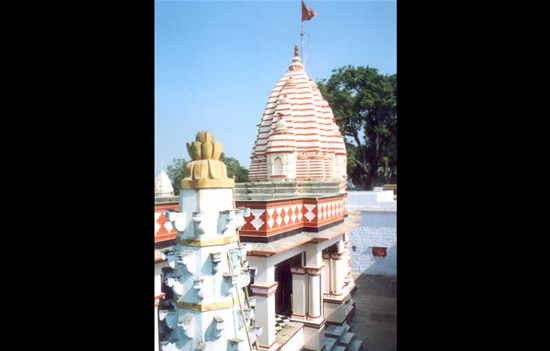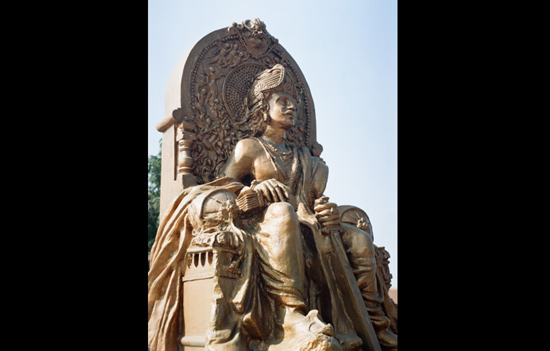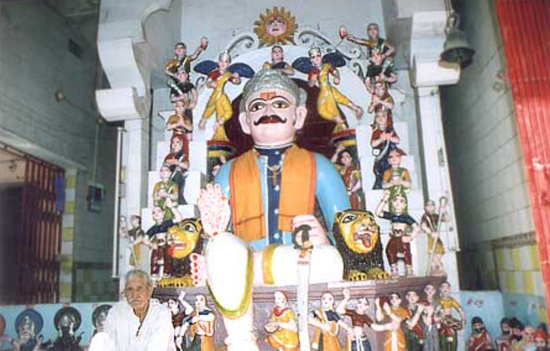- Know about the Gupta kings. Why is their rule considered the Golden Age of India? How did Vikram Samvat come into being?
This article is based on Volume 3 of The History and Culture of Indian People published
by the Bharatiya Vidya Bhawan. All
credits to authors. Copyright Bhavan. I have only compiled for your
convenience.
Article tells about individual kings of the Gupta Empire.
Foreword by Kulapati K M Munshi,
excerpts.
“About 320 A.D., Chandra-gupta I, the founder of the Gupta Empire,
revived the chakravarti ideal in North India. His marriage with Kumaradevi, the
Lichchavi princess, probably resulted in the union of her principality with
Magadha.” Pg. x
“Placed between 335-350 A.D. Samundragupta laid the foundation of
a military machine which probably included a navy. The territory from Haridwar
to the borders of Assam was consolidated into a compact homeland which he
directly administered.” Pg xi
“Politically, this was the age of the integration in India. After more
than 300 years, northern India was again united under a powerful monarch of
versatile talents. A man of culture and patron of arts and letters, he became a
symbol and architect of a mighty creative urge amongst the people, which while
drawing vitality from tradition, took on a new shape and power.” Pg xi
Next was his son Chandragupta II (376-414), known as Vikramaditya,
acclaimed as the greatest of the Gupta emperors. His reign is placed between
376 and 414. The direct sway of Pataliputra extended from the Bay of Bengal to
the Arabian Sea. South of the Narmada-was dominated by two friendly powers the
Pallavas and Vartakas.” Pg xi He
defeated the Saka chiefs who had been ruling Gujarat for more than 300 years.
“In the collective conscious of India, Vikramaditya symbolised the highest aspirations of national greatness.” Pg
xii
“Next was his son Kumara-gupta (415-55 a.d.) and grandson, Skanda-gupta (455 to 467 a.d.) who inflicted a defeat on the
invading Hunas.”
“The Dharma-sastras
were not enforced at the point of the sword. Even the backward and immigrant
classes dropped their group, customs and usages and cheerfully adopted the
social system prescribed by them.” Pg
xiii
“Sanskrit, a living language, elastic in
structure and rich in expression, was the living embodiment of the Dharma was a
powerful integrating force. Inscriptions began to be written in Sanskrit, even
in the far South.” Pg xiii
“The Gupta emperors upheld Dharma. Under the Gupta emperors, the Mahabharata acquired a unique position
as an integrating psychological course. The cultural uprising was based upon
the central idea underlying Dharma
from early time. The age saw the speculative thought among others of Vasubandhu
and the Nayanars; the perfect lyric and drama of Kaildasa; the astronomical
discoveries of Varahamihira; the iron pillar of Delhi; the beginnings of
structural temples; the beauty of the early Ajanta frescoes; the rise of
Vaishnavism and Saivism; completion of Mahabharata and composition of the Vayu-
and the Matsya Puranas. Greatness of the empire lay in its integral outlook.” Pg xiv
“Its strength was based as much on
military strength as on internal order and economic policy; the sap of its vitality was drawn from
ancient tradition which they maintained, re-interpreted and replenished.”
“The Gupta emperors became the symbols
of a tremendous national upsurge. Life was never happier, our culture never
more creative than during the Golden Prime of India.” Pg xv
Although the Guptas were devoted to
Vishnu, the worship of Siva was more popular. Kanchi became a great centre of
faith. After 500 A.D. the Bhakti cults gave to the religious movements the
emotional content. It helped form enduring values which helped people during
the disastrous Turkish invasions.
By 512 a.d. the Huns, under Toramana,
overran north India. They were resisted and defeated. They disappeared as they
came. The Guptas had grown weak, the Maukharis emerged victorious. Kanauj
emerged as the symbol of a new order.
Dr R
C Mazumdar
wrote in same volume (3),” it is during this period that Indian intellect
reached its high watermark. The period witnesses the highest development of
Sanskrit literature.” The six systems of Philosophy, took place during this
period, which also produced great Buddhist philosopher like Vasubandhu.
“We have the shining figures of
Aryabhata, Varahamihiri and Brahmagupta, whose works in Maths and Astronomy are
still reckoned to be the greatest contribution of India to science in the
ancient world. It will be enough to recall the fact that Aryabhatta was the
first to discover that the earth rotates on its axis and moves around the sun. The
discovery of the decimal system of notation has revolutionised the process of
arithmetical calculation. As regards technical science, the great iron pillar
at Mehrauli is a triumph of metallurgy.” Pg
xvi
This period (320-750) saw the final
development of the two great epics, growth of Vaishnavism and Saivism. The vast
Puranic literature took definite shape during this period.
“During the Gupta Age this cultural
unity overspread the natural physical boundaries of India.” During this period
Indian culture spread to Southeast Asia and Central Asia. There was a cultural
renaissance in India during the Gupta Age.
“The intellectual greatness which characterised
the Gupta Age was typified in the University of Nalanda.” Pg xxviii
 Sri
Gadhkalika Mandir Ujjain is traditionally known to be the choice of worship of
Kalidasa.
Sri
Gadhkalika Mandir Ujjain is traditionally known to be the choice of worship of
Kalidasa.
Now let us look at the kings of the Gupta
empire.
1. Rise of the Guptas
The dissolution of the Kushanas
continued right up to the beginning of the 4th century a.d. Kushanas
ruled over western Punjab. The Sakas ruled over Gujarat and part of Malwa but
power was on the decline. The rest of Northern India was divided into small
kingdoms.
Guptas origin seems to be somewhere in
modern day Central India, perhaps Rewa. The first three rulers are referred to
as Srigupta, Sri Ghatotkacha-gupta and his son Sri Chandra-gupta (Chandragupta
I). It is generally assumed that the well known Gupta Era started with the
accession to the throne by Chandragupta I on 26/2/320 A.D. He probably ruled
over the whole of Bihar and parts of U.P. and Bengal. Origin of the Gupta name
is not known.
2. Foundation of the Gupta
Empire
To know about the military exploits of Samudra-gupta (SG) read what is engraved on the
Asoka pillar at Prayagraj.
Areas directly under the administration
of SG-In the east, it included the whole of Bengal, excepting its south-eastern
extremity. Its northern boundary ran along the foothills of the Himalayas. In
the west it includes parts of Punjab. The southern line ran along with the
Vindhya range of hills. Book has details.
SG also made expeditions to the Deccan
and defeated no less than 12 rulers. He captured some southern states but
allowed them to rule as feudatories. Even Ceylon was included as a vassal state
like that of the Sakas and Kushanas. King Meghavarna of Ceylon (353-379) sought
and obtained permission from SG to build a monastery and rest-house at Bodhgaya
for Ceylonese devotees.
SG’s empire comprised of the whole of
Northern India excluding Kashmir, Western Punjab and Rajputana, Sindh and
Gujarat and included the highlands of Chhattisgarh and Orissa with a long
stretch along the eastern coasts extending as far south as Chingleput. He was a
great patron of learning, a poet and a musician. SG died around 380 A.D.
Chandra-gupta II (CG)
became king around 376 a.d. and lived till about 413 a.d.
 Vikramaditya, Vikram University, Ujjain.
Vikramaditya, Vikram University, Ujjain.
CG defeated the Saka ruler of Gujarat
and Kathiawar Peninsula around 1st decade of the 5th
century. The Gupta empire also controlled to a large extent Indian commerce
with the western world.
CG exploits make one compare him with
king Vikramaditya of Ujjain who is supposed to have expelled the first Saka
conquerors over 400 years ago. It is likely that some of the traditions, esp.
patronage of learning, associated with CG owed their origin to the historic
king. But it is true that the famous poet Kaildasa (one of the 9 gems of CG)
lived at the court of CG. He had successful military expeditions in East Bengal
and Bactria beyond the Hindu Kush.
CG introduced copper and silver unlike
his predecessors who had only gold coins. Reverse of the coin had Garuda, vehicle of Lord Vishnu. The
brilliant intellectual revival in arts, literature and science took places
under SG, CG. They brought about peace which made possible progress of culture
& civilization.
Kumara-Gupta I (415 to 455
a.d.)
He was son of CG who maintained the vast
empire that was inherited.
Skanda-Gupta (SG – died
about 467 a.d.)
He defeated the Hunas. For nearly half a
century after that the Gupta empire was immune from their depredations. He was a saviour of India for the Hunas had
established their supremacy in Europe.
Budha-gupta died
about 500 a.d. He seems to have been the last Gupta emperor to have enjoyed
sovereignty over the vast dominions bequeathed to him by Chandra-gupta II.
Indian civilization progressed
because there was peace & prosperity.
3. Disintegration of the
Empire
The Hunas invaded again and brought
chaos/barbarism (Toramana and Mihirakula), contributed to the disintegration of
the Gupta empire. They were defeated by the Maukharis (pg. 38)
The Maukharis and later Guptas became
independent rulers. Several powerful feudatories of the Gupta empire also rose.
Narasimha-gupta was the last great Gupta
emperor. He was succeeded by his son and grandson (about 535-570 a.d.)
The decline and downfall was brought
about by internal dissension in the royal family and rebellion of feudal chiefs
and regional satraps, though foreign invasion was an important contributing
factor.
It is generally accepted that Kalidasa flourished during the Gupta Age, period
between 100 B.C. and A.D. 450. His best known work is Sakuntla. It was based on
the story of Sakuntla as found in the Mahabharata. He was also brilliant in
poetry. His two Mahakavyas, Raghuvamsa and Kumarasambhava and the lyrical poem Meghaduta are accepted as gems of Sanskrit poetry. Pg 302
The Udaygiri
Caves at Vidisha near Bhopal contain inscriptions belonging to the region of Chandra-gupta II, one of which is dated 401 A.D. Pg. 488 See video talk by art historian Benoy K Behl on Sublime Art in Gupta period 51 minutes
The Gupta period heralded a new period
in Indian temple architecture. Earlier
shrines were made of perishable items like wood, bamboo. Now temples were made
in permanent materials, esp. brick and dressed stone.
Aihole in
Karnataka is said to be the cradle of Indian Temple architecture
During the Gupta Age inter-caste
weddings took place esp. of Brahmins and Kshatriyas marrying Vaisyas and
Sudras. Pg. 561
 Vikramaditya Temple in Ujjain.
Vikramaditya Temple in Ujjain.
Was Vikramaditya (CG II)
the founder of Vikram Samvat?
There are conflicting views. I will
dwell in brief.
Some say Vikramaditya was the ruler who
defeated the Sakas in 58 B.C. and founded the era Vikrama Samvat – to
commemorate this fact. CGII’s association
with Kalidasa is accepted but learned do not think Kalidasa lived so early a
period. The general view he lived during the period of CGII, who too defeated
the Sakas. Kalidasa is said to have lived between 100 BC and 450 AD.
As per chapter 10 of Volume 2 of
Bhavan’s eleven volumes there is a reference to Jain literature and partly in
connection with history of Jaina darsana.
Thus, Vikramaditya, son of ruler
Gardabhilla, regained the kingdom of Ujjayini by expelling the Sakas. So
commenced the Vikrama era in 58 BC. When the Sakas regained control of Ujjayani
about 135 years later then commenced the Saka era in 78 A.D. Pg. 155
“For the first five hundred years, the
years of the era were simply referred to as Samvat. In the 5th
century A.D. the era is for the first time called the ‘era of Malavas’. The
earliest use of the word Vikrama is in an inscription in which 898 is referred
to the time called Vikrama. Had it been founded by king Vikramaditya it would
have been more than strange that no allusion should ever have been made for
this for more than a thousand years.” Pg
156
This explains why I found a Vikramaditya
temple in Ujjain.
Also
read
1. Hindu calendar
explained
2. Informative blog
on subject
3. The tragedy of
Vikram Samvat
4. Ganesha speaks
about Vikram Samvat
5. Album Jantar
Mantar Observatory, Ujjain
6. About history of
Ujjain
7. When it all
began – Indian calendars
8. Renowned
Mathematicians of India
9. Education –
words of Sri Aurobindo and the Mother
10. See video talk by art historian Benoy K Behl on Sublime Art in Gupta period 51 minutes